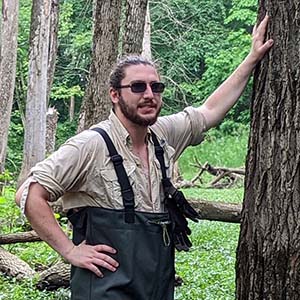These talks, held both days of the Spring Symposium, provide an opportunity for ecology-focused graduate and undergraduate students and postdoctoral scientists to share their research.
Geographic Trends in the Niche Space of Microbial Consortia Within the Northern Pitcher Plant (Sarracenia purpurea)
Grace Cagle
 Many of the important functions performed by microorganisms are emergent properties of complex associations among microbial taxa and their environment. At large (e.g., continental) spatial scales, these associations may be detectable through species co-occurrence relationships, which can also reflect niche processes that drive coexistence and the maintenance of diversity. For example, network modularity, in which distinct subsets of a network are more connected with each other than the rest of the network, can represent niche space. However, whether there are patterns of microbial coexistence across large spatial scales is not well understood.
Many of the important functions performed by microorganisms are emergent properties of complex associations among microbial taxa and their environment. At large (e.g., continental) spatial scales, these associations may be detectable through species co-occurrence relationships, which can also reflect niche processes that drive coexistence and the maintenance of diversity. For example, network modularity, in which distinct subsets of a network are more connected with each other than the rest of the network, can represent niche space. However, whether there are patterns of microbial coexistence across large spatial scales is not well understood.
To determine whether microbiomes exhibit spatial variation in cooccurrence dynamics, and the ecological processes underlying these dynamics, we conducted a continental-scale network analysis of the bacterial inhabitants of the Pitcher Plant (Sarracenia purpurea). We assessed the microbiomes of 108 S. purpurea pitchers using a single co-occurrence network. Our analysis revealed one module that was significantly and negatively correlated with latitude, indicating a niche that may be unique to low-latitude pitchers. The phylogenetic relatedness of taxa within modules was significantly greater than expected, supporting our interpretation of modules as representative of niche space.
We identified “hub” taxa, defined as those with high centrality scores, tended to be hubs across the range of the plant, indicating these species may have a high impact on the system across its range. In summary, microbial co-occurrences in the model system S. purpurea were largely consistent across the range of the plant and subjected to selective forces that promoted evolutionary relatedness amongst co-occurring taxa.
A Landscape of R: How Wildlife Behavior and Pathogen Environmental Persistence Shape the Epidemiology of an Anthrax Reservoir
Amélie Dolfi
 Environmentally transmitted diseases, caused by pathogens that can survive for long periods of time, represent a large portion of the most burdensome world diseases. Hosts can release pathogens into the environment via different means, such as urine, saliva, or blood, and localizing the infectious patch within the environment can prove very challenging. If the pathogen persists in the environment for a long period, it can be responsible for maintaining or sparking outbreaks long after the last outbreak has faded from an area.
Environmentally transmitted diseases, caused by pathogens that can survive for long periods of time, represent a large portion of the most burdensome world diseases. Hosts can release pathogens into the environment via different means, such as urine, saliva, or blood, and localizing the infectious patch within the environment can prove very challenging. If the pathogen persists in the environment for a long period, it can be responsible for maintaining or sparking outbreaks long after the last outbreak has faded from an area.
The ability to estimate the basic reproduction number R of an environmentally transmitted disease, defined in our study as the number of naive individuals, on average, infected by one infectious patch over its entire survival, is essential to comprehend environmentally transmitted disease dynamics and transmission risks.
Here, we assessed the R for environmental reservoir patches of the anthrax bacterium Bacillus anthracis in Etosha National Park, Namibia. Anthrax reservoir patches are created when an infected individual dies, and Bacillus anthracis can persist in the surface soil for up to 10 years. Using data on host visitations, pathogen concentrations, and simulation models, we show that hosts graze more often on reservoirs than non-reservoir sites and that, on average, under good environmental conditions, one infectious patch will infect seven hosts over a 10-year period, with most infections occurring within the first five years.
Using long-term data on anthrax concentrations, and fine-scale information on hosts behavior, we were able to estimate the R of a persistent environmentally transmitted pathogen in free-ranging wildlife.
A Cross Inoculation Experiment Reveals Ophidiomyces Ophiodiicola and Nannizziopsis Guarroi Can Each Infect both Snakes and Lizards
Savannah Gentry
 Host range and specificity are key concepts in the study of infectious diseases. However, both concepts remain largely undefined for many influential pathogens, including many fungi within the Onygenales order. This order encompasses reptile-infecting genera (Nannizziopsis, Emydomyces, Ophidiomyces, and Paranannizziopsis) formerly classified as the Chrysosporium anamorph of Nannizziopsis viresii (CANV). Reported hosts for many of these fungi represent a narrow range of phylogenetically related animals, suggesting many of these disease-causing fungi are host-specific, but the true number of species affected by these pathogens is unknown.
Host range and specificity are key concepts in the study of infectious diseases. However, both concepts remain largely undefined for many influential pathogens, including many fungi within the Onygenales order. This order encompasses reptile-infecting genera (Nannizziopsis, Emydomyces, Ophidiomyces, and Paranannizziopsis) formerly classified as the Chrysosporium anamorph of Nannizziopsis viresii (CANV). Reported hosts for many of these fungi represent a narrow range of phylogenetically related animals, suggesting many of these disease-causing fungi are host-specific, but the true number of species affected by these pathogens is unknown.
For example, to date, Nannizziopsis guarroi (the causative agent of yellow fungus disease) and Ophidiomyces ophiodiicola (the causative agent of snake fungal disease) have only been documented in lizards and snakes, respectively. In a 52-day reciprocal infection experiment, we tested the ability of these two pathogens to infect currently unreported hosts, inoculating central bearded dragons (Pogona vitticeps) with O. ophiodiicola and corn snakes (Pantherophis guttatus) with N. guarroi.
We confirmed infection by documenting both clinical signs and histopathological evidence of fungal infection. Our reciprocity experiment resulted in 100 percent of corn snakes and 60 percent of bearded dragons developing infection with N. guarroi and O. ophiodiicola, respectively, demonstrating that these fungal pathogens have a broader host range than previously thought, and that hosts with cryptic infections may play a role in pathogen translocation and transmission.
Gotta Fan ’Em All: Using Automated Computer-Vision-Based Tracking to Understand the Impacts of Heatwaves on Social Thermoregulation in Bumblebees
Grace Melone
 Bumblebees are a diverse group of important wild and managed pollinators in temperate regions across the globe. Climate change, and particularly extreme heat events, are likely negatively impacting bumblebee populations, but the mechanisms underlying these impacts are not well understood.
Bumblebees are a diverse group of important wild and managed pollinators in temperate regions across the globe. Climate change, and particularly extreme heat events, are likely negatively impacting bumblebee populations, but the mechanisms underlying these impacts are not well understood.
Here, I investigate the impacts of multiday heatwaves on collective thermoregulation within bumble bee colonies, specifically focusing on how heat wave progression and nutritional status affect thermoregulatory behavior. I predict nonlinearity in fanning throughout the heatwave, through two possible mechanisms: 1) nutrition limiting energetic capacity, with low nutrition bees fanning less, or 2) acclimation to heat stress decreasing fanning throughout the heatwave.
I exposed groups of bumble bee (Bombus impatiens) workers to a three-day heatwave and quantified the impacts on fanning behavior, which bees employ to cool the colony when temperatures exceed optimal ranges. To overcome the challenge of quantifying fanning behavior of individual bees, we automated video capture and analysis using a low-cost, automated imaging system based on RaspberryPi microcomputers and cameras. I integrated tag-based tracking of uniquely identified individual workers (ArUco) with pose estimation (i.e. tracking of individual body parts) to quantify behavior throughout the experiment. These scalable, automated approaches allow for high-resolution studies of dynamic behavioral responses to stressors like heat, nutrition, and pesticides, at high resolution. In future research, I will apply them to study how multiple stressors interact to affect behavior, and how successful fanning is at improving larval survival.
Assessing Microbial Response to Recovery from Historically High Rates of Anthropogenic Nitrogen Deposition in Northern Hardwood Forests of the Upper Great Lakes region
Brooke Propson
 Increased anthropogenic nitrogen (N) deposition to historically N-limited forests has resulted in their increased capacity to store soil carbon (C). This increase in soil C is attributable to reductions in microbially-mediated organic matter (OM) decay, enhancing this globally relevant terrestrial C sink. However, since the implementation of the Clean Air Act Amendments in 1990, anthropogenic emissions of reactive N have greatly declined. As a result, it’s imperative to understand how forests, and the C sink that they support, recover from high rates of N deposition.
Increased anthropogenic nitrogen (N) deposition to historically N-limited forests has resulted in their increased capacity to store soil carbon (C). This increase in soil C is attributable to reductions in microbially-mediated organic matter (OM) decay, enhancing this globally relevant terrestrial C sink. However, since the implementation of the Clean Air Act Amendments in 1990, anthropogenic emissions of reactive N have greatly declined. As a result, it’s imperative to understand how forests, and the C sink that they support, recover from high rates of N deposition.
In this study, we utilize a long-term field study in which increased N deposition was experimentally applied to replicate northern hardwood forest stands in Michigan, USA from 1994–2017. The goal of this project is to assess whether the increased terrestrial C sink that was supported under high rates of anthropogenic N deposition persists when N deposition is reduced and assess if reduced N conditions have elicited changes in soil microbial activity responsible for governing the fate of soil C.
We determined that the C content and mass of forest floor are no longer built-up in the previously fertilized plots and often exhibit significant deficits compared to ambient conditions, yet increased C in mineral soils persists. Enzyme activity associated with OM breakdown is generally no longer suppressed in the forest floor yet exhibit legacy effects in mineral soils. Taken together, these results suggest that forest soil C built-up under high anthropogenic N deposition is a transient C sink and will likely reduce as N deposition declines.
Out of the Swamp, into the Poplar Zeitgeist: Phytochemical Diversity in Populus Heterophylla and Implications for Salicinoid Diversity in Populus
Tyler Wintermute

The model tree genus Populus has a long history of research in Wisconsin, notably contributing to foundational work on the chemical ecology of these widespread and often dominant tree species. However, much of this research has been inherently focused on a few anti-herbivore salicinoid phenolic glycoside (SPG) compounds characteristic of the most common species.
Populus heterophylla (swamp cottonwood) is a rare swamp tree species endangered in several states and Canada that has an overwhelming diversity of SPGs, many of which have received limited or no attention. Work on questions about biogeographical and ontogenetic patterns of SPG diversity in this understudied tree species has implications for SPG diversity in Populus and contributes a new system to explore avenues and perspectives of phytochemical diversity for plants, particularly as they relate to defense.
To wade through these questions, I collected leaves from 52 swamps throughout P. heterophylla’s U-shaped range in eastern North America. Using UHPLC-MS/MS, I identified three chemical phenotypes (chemotypes) and over 30 SPGs in the species, with populations east of the Appalachian Mountains consisting of chemotypes with better defensive properties than those west of the Appalachians. From a subset of 17 swamps, I planted trees in a common garden at UW–Madison Arlington Agricultural Research Station.
Using the sink-source leaf model of resource acquisition, I tested classic Optimal Defense (OD) questions in this chemically-rich species and found that, in addition to the expected quantitative increase in defense of young leaves predicted by OD, P. heterophylla deploys a qualitative OD, shifting the composition of its suite of SPGs between young and old leaves. These patterns suggest that SPGs might not all have a similar function in terms of fitness benefits. Future work with bioassays and population genetic structure analysis can provide further clarity into the evolutionary origins of these important drivers of ecological processes.